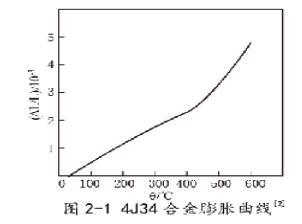Product classification

4J34 precision alloy
4J34 is a ceramic sealing alloy developed based on the characteristics of ceramics in our country. The alloy has a linear expansion coefficient similar to that of 95% Al2O3 ceramics within the temperature range of -60℃ to 600℃. It is mainly used for matching seals with ceramics and is an important sealing structural material in the vacuum electronics industry.
Classification:
Key words:
Superalloy | Inkenel | Hastelloy | Inkloy | Precision Alloy Series
Product Parameters
4J34
Material grade: 4J34 precision alloy
Russian grade: 31HК(Ni31Co20)/24HК(Ni25Co28)
American grade: Ceramvar(Ni27Co25)
German grade: Vacon20(Ni28Co20)
1. Overview of 4J34 precision alloy:
4J34 is a ceramic sealing alloy developed based on the characteristics of ceramics in our country. The alloy has a linear expansion coefficient similar to that of 95% Al2O3, within the temperature range of -60℃ to 600℃. It is mainly used for matching seals with ceramics and is an important sealing structural material in the electric vacuum industry.
1. 4J34 material grade: 4J34.
2. Similar grades to 4J34: see Table 1-1.
Table 1-1
| Russia | USA | Germany |
| 31HК(Ni31Co20) / 24HК(Ni25Co28) | Ceramvar(Ni27Co25) | Vacon20(Ni28Co20) |
3. Technical standards for 4J34 material:
4. Chemical composition of 4J34: See Table 1-2.
Table 1-2
| C≤ | Si≤ | Mn≤ | P≤ | S≤ | Cr≥ | Ni≥ | Mo≥ | Cu≤ |
| 0.05 | 0.30 | 0.50 | 0.020 | 0.020 | - | 28.5-29.5 | - | - |
| Others | Al≤ | Ti≤ | Fe≤ | Co≤ | V≤ | W≤ | Nb≤ | N≤ |
| - | - | Remaining | 19.5-20.5 | - | - | - | - |
Under the condition that the average linear expansion coefficient meets the standard requirements, deviations in nickel and cobalt content from the ranges specified in Table 1-2 are allowed.
5. Heat treatment system for 4J34: The standard specifies that the expansion coefficient and low-temperature microstructure stability performance test samples should be heated to 900℃±20℃ in a protective atmosphere or vacuum, held for 1 hour, and then cooled to below 200℃ at a rate not exceeding 5℃/min.
6. Varieties, specifications, and supply status of 4J34: Varieties include wire, tube, plate, strip, and bar.
7. Melting and casting process of 4J34: Melted using non-vacuum induction furnace, vacuum induction furnace, or electric arc furnace.
8. Application overview and special requirements of 4J34: This alloy has been used for a long time in aviation factories, with stable performance. It is mainly used for sealing electric vacuum components with Al2O3ceramics. It is used to manufacture electrodes, lead plates, and lead wires for large electronic tubes and magnetrons. During use, the selected ceramics should match the expansion coefficient of the alloy. When selecting the alloy, the low-temperature microstructure stability should be strictly tested according to the usage temperature. Appropriate heat treatment should be carried out during processing to ensure that the material has good deep drawing and stretching performance. When using forged materials, their airtightness should be strictly tested.
2. Physical and chemical properties of 4J34:
1. Thermal properties of 4J34:
(1) Melting temperature range of 4J34: The melting temperature of this alloy is approximately 1450℃.
(2) Thermal conductivity of 4J34:
(3) Linear expansion coefficient of 4J34: The average linear expansion coefficient of the alloy as specified in the standard is shown in Table 2-1.
The average linear expansion coefficient of this alloy is shown in Table 2-2. The expansion curve of 4J34 alloy is shown in Figure 2-1.
Table 2-1 Table 2-2
| /10-6℃-1 | /10-6℃-1 | ||||||
| 20~400℃ | 20~500℃ | 20~600℃ | 20~300℃ | 20~400℃ | 20~500℃ | 20~600℃ | |
| 6.3~7.1 | - | 7.8~8.5 | 6.8 | 6.4 | 6.8 | 8.2 | |
2. Density of 4J34: ρ=8.29g/cm3
3. Electrical properties of 4J34:
(1) Resistivity of 4J34: ρ=0.45μΩ·m
(2) Temperature coefficient of resistance of 4J34:
4. Magnetic properties of 4J34:
(1) Curie point of 4J34: Tc=470℃
(2) Magnetic properties of 4J34 alloy: see Table 2-6.
Table 2-6
| H/(A/m) | B/T | H/(A/m) | B/T |
| 8 | 0.7×10-2 | 160 | 0.65 |
| 16 | 1.5×10-2 | 400 | 1.01 |
| 24 | 2.7×10-2 | 800 | 1.21 |
| 40 | 5.6×10-2 | 2000 | 1.46 |
| 80 | 0.25 | 4000 | 1.62 |
At 4000A/m, the residual magnetic induction Br=0.89T, coercive force Hc=83.2A/m
5. Chemical properties of 4J34: This alloy has good corrosion resistance in the atmosphere, fresh water, and seawater.
3. Mechanical properties of 4J34:
1. Performance specified by the technical standards for 4J34:
(1) Hardness of 4J34: The hardness of deep-drawn strip should meet the requirements of Table 3-1. Strips with a thickness not exceeding 0.2mm are not subjected to hardness testing.
Table 3-1
| Condition | δ/mm | HV |
| Deep-drawn state | >2.5 | ≤170 |
| ≤2.5 | ≤165 |
(1) Tensile strength of 4J34: The tensile strength of wire and strip should meet the requirements of Table 3-2.
Table 3-2
| Condition code | Condition | σb/MPa | |
| Wire | Strip | ||
| R | Soft state | <585 | <570 |
| Y | Hard state | >860 | >700 |
2. Mechanical properties of 4J34 at room temperature and various temperatures:
(1) Hardness of 4J34: The hardness of the alloy strip (annealed state) is shown in Table 3-3.
(2) Tensile properties of 4J34: The tensile properties of the alloy (annealed state) at room temperature are shown in Table 3-3.
Table 3-3
| σb/MPa | σP0.2/MPa | δ/% | HV |
| 539 | 343 | 32 | 158 |
3. Durability and creep properties of 4J34:
4. Fatigue properties of 4J34:
5. Elastic properties of 4J34: Elastic modulus E=142GPa.
4. Microstructure of 4J34:
1. Phase transformation temperature of 4J34: The γ→α phase transformation temperature of 4J34 alloy is below -80℃.
2. Time-temperature-structure transformation curve of 4J34:
3. Microstructure of 4J34 alloy: The structure of this alloy is single-phase austenite. After treatment according to the heat treatment system specified in 1.5, 4J34 should not exhibit martensitic structure after being frozen at -78.5℃. When the alloy composition is improper, different degrees of austenite (γ) to needle-like martensite (α) transformation will occur at room temperature or low temperature. The phase transformation is accompanied by a volume expansion effect. The expansion coefficient of the alloy increases accordingly, leading to a significant increase in internal stress of the sealing components, and even causing partial damage. The main factor affecting the stability of the alloy's low-temperature structure is the chemical composition of the alloy. From the Fe-Ni-Co ternary phase diagram, it can be seen that nickel is the main element that stabilizes the austenite (γ) phase, and a higher nickel content is beneficial for the stability of the γ phase. As the total deformation rate of the alloy increases, its structure tends to stabilize. The segregation of the alloy composition may also cause local γ→α phase transformation. In addition, coarse grains will also promote the γ→α phase transformation.[2,5,6].
4. Grain size of 4J34: The standard stipulates that the grain size of deep-drawn strip should not be less than grade 7, and the grains smaller than grade 7 should not exceed 10% of the area. For strips with a thickness of less than 0.13mm, when estimating the average grain size, the number of grains along the thickness direction of the strip should not be less than 8.
5. Process performance and requirements of 4J34:
1. Formability of 4J34: This alloy has good cold and hot working performance and can be made into various complex-shaped parts. However, heating in a sulfur-containing atmosphere should be avoided. During cold processing, the cold strain rate of the strip is greater than 70%, and annealing will cause plastic anisotropy. When the strain rate is within 10% to 15%, the alloy will cause rapid grain growth during annealing, which will also produce plastic anisotropy of the alloy. When the final strain rate is 60% to 65% and the grain size is 7 to 8.5, the plastic anisotropy is minimized.
2. Welding performance of 4J34: This alloy can be welded to metals such as copper, steel, and nickel using methods such as brazing, fusion welding, and resistance welding. When the zirconium content in the alloy exceeds 0.06%, it will affect the quality of argon arc welding of the plate, even causing cracks in the weld.
Parts of this alloy should be annealed, cleaned, and nickel-plated before sealing with ceramics, and then sealed with silver solder to the ceramic parts that have been metallized and nickel-plated.
3. Heat treatment process of 4J34 parts: Heat treatment can be divided into: stress relief annealing and intermediate annealing.
(1) Stress relief annealing: To eliminate the residual stress in parts after machining, stress relief annealing should be performed at 470–540℃, holding for 1–2 hours, followed by furnace cooling or air cooling.
(2) Intermediate annealing: To eliminate the work hardening caused by cold rolling, cold drawing, and cold stamping of the alloy, facilitating further processing. The workpiece needs to be heated in dry hydrogen, decomposed ammonia, or vacuum to 750–900℃, holding for 15 minutes to 1 hour, then furnace cooled, air cooled, or water quenched.
This alloy cannot be hardened by heat treatment.
4. 4J34 surface treatment process: Surface treatment can be done by sandblasting, polishing, or pickling. This alloy has good electroplating performance, and the surface can be plated with metals such as gold, silver, nickel, and chromium.
5. 4J34 cutting and grinding performance: The cutting characteristics of this alloy are similar to those of austenitic stainless steel. High-speed steel or carbide tools are used for low-speed cutting. Coolants can be used during cutting. This alloy has good grinding performance.
6. 4J34 varieties, specifications, and supply status:
1,Specifications: Seamless pipes, steel plates, round steel, forgings, flanges, rings, welded pipes, steel strips, wire materials, and matching welding materials.
2. Delivery status: Seamless pipes: solid solution + acid pickled, length can be customized; plates: solid solution, acid pickled, trimmed; welded pipes: solid solution acid pickled + RT% flaw detection, forgings: annealed + turned; bars in forged state, surface polished or turned; strips delivered in cold-rolled, solid solution soft state, and descaled; wire materials delivered in solid solution acid pickled coil or straight bar form, solid solution straight bar finely polished state.
Previous Page
Next Page
Previous Page
None
Next Page
Related Products
Product Consulting
Leave your contact information to get a free product quote!







